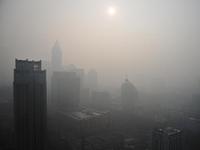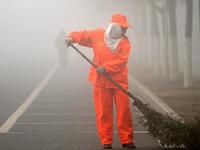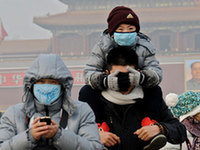Dense smog hits east, central China
 0 Comment(s)
0 Comment(s) Print
Print E-mail China.org.cn, January 14, 2013
E-mail China.org.cn, January 14, 2013

|
Introductory guide to fog, haze, smog and PM2.5 |
|
• Fog is a collection of liquid water droplets or ice crystals suspended in the air at or near the Earth's surface. |
|
• Haze is traditionally an atmospheric phenomenon where dust, smoke and other dry particles obscure the clarity of the sky. |
|
• Smog is a type of air pollution; the word "smog" was coined in the early 20th century as a portmanteau of the words smoke and fog to refer to smoky fog. |
|
• PM2.5 particles are air pollutants with a diameter of 2.5 micrometers or less, small enough to invade even the smallest airways. |
|
|
|
The Great Smog of 1952 The Great Smog of 1952 or Big Smoke was a severe air pollution event that affected London from December 5 to 9, 1952. It is known to be the worst air pollution event in the history of the United Kingdom. It mixed with black smoke emitted from homes and factories to create a deadly smog, leaving at least 12,000 people dead.
|
|
What did London do to reduce air pollution?
• Environmental legislation Local government in London released a series of environmental laws and regulations since 1952, such as the City of London Act 1954 and the Clean Air Acts of 1956 and 1968. Clean Air Acts of 1956 was an important milestone in the development of a legal framework to protect the environment. The Act introduced an idea of "smokelesszones" where smokeless fuels only could be burnt. Power stations were also moved to more rural areas and sulpher dioxide levels were reduced by introducing cleaner fuel sources.
• Set emission reduction targets The 2007 Air Quality Strategy introduced a new exposure reduction regime for PM2.5, claiming that PM2.5 annual average must be less than 25 micrograms per cubic meter in roads and other highly polluted areas. The regime, for the first time, attempted to reduce the exposure of all urban dwellers.
• Develop new technology London explored a new technology to tackle the air pollution by spreading calcium magnesium acetate on the city's busiest roads, which just likes "pollution glue" to absorb dangerous chemicals out of the air and "glue" them to the tarmac.
|
|
The correct way to use a dust mask | ||||
|
|
|
|
|
 |













Go to Forum >>0 Comment(s)